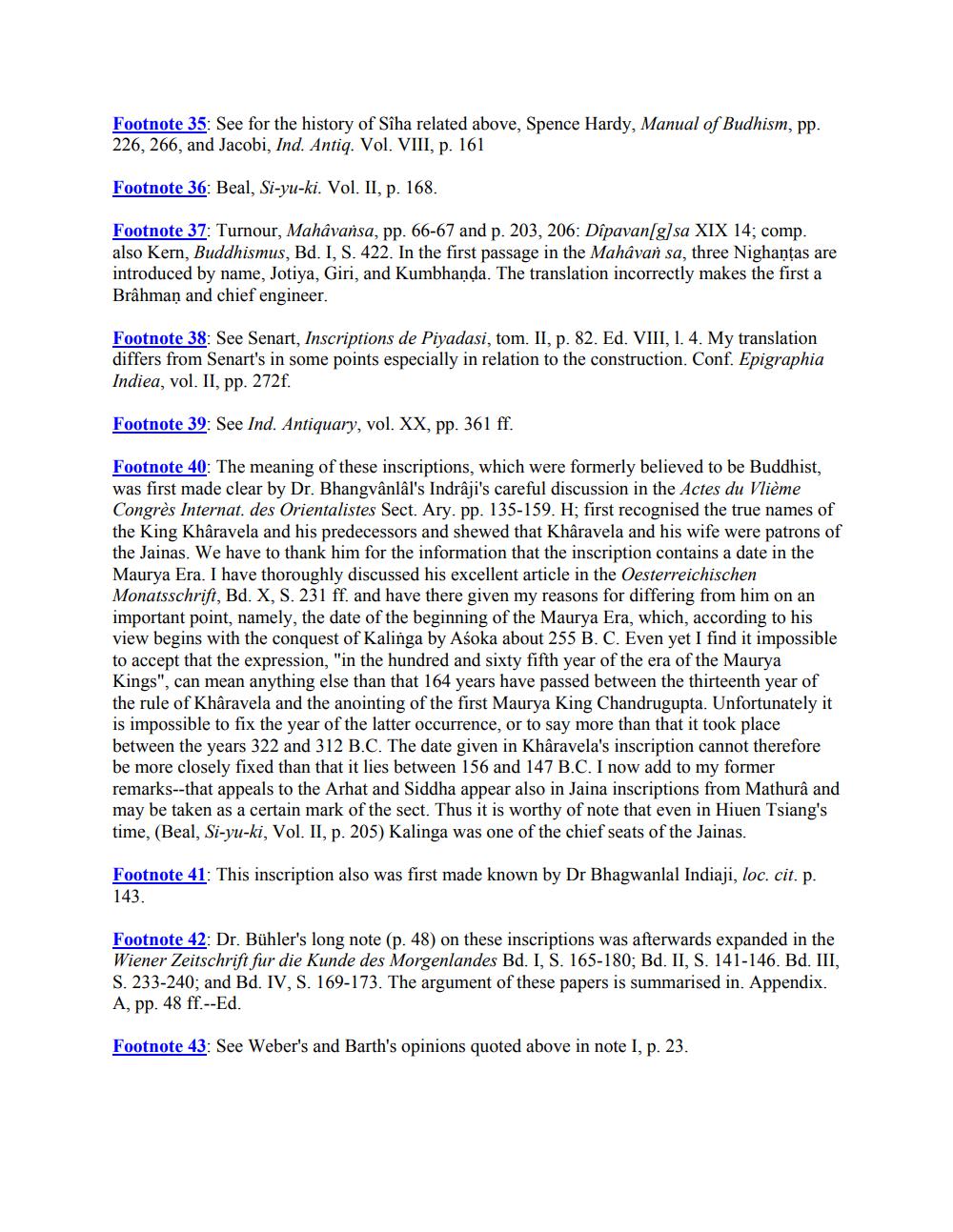________________
Footnote 35: See for the history of Sîha related above, Spence Hardy, Manual of Budhism, pp. 226, 266, and Jacobi, Ind. Antiq. Vol. VIII, p. 161
Footnote 36: Beal, Si-yu-ki. Vol. II, p. 168.
Footnote 37: Tumour, Mahavansa, pp. 66-67 and p. 203, 206: Dipavan[g]sa XIX 14; comp. also Kern, Buddhismus, Bd. I, S. 422. In the first passage in the Mahavan sa, three Nighantas are introduced by name, Jotiya, Giri, and Kumbhanda. The translation incorrectly makes the first a Brâhman and chief engineer.
Footnote 38: See Senart, Inscriptions de Piyadasi, tom. II, p. 82. Ed. VIII, 1. 4. My translation differs from Senart's in some points especially in relation to the construction. Conf. Epigraphia Indiea, vol. II, pp. 272f.
Footnote 39: See Ind. Antiquary, vol. XX, pp. 361 ff.
Footnote 40: The meaning of these inscriptions, which were formerly believed to be Buddhist, was first made clear by Dr. Bhangvânlâl's Indrâji's careful discussion in the Actes du Vlième Congrès Internat. des Orientalistes Sect. Ary. pp. 135-159. H; first recognised the true names of the King Khåravela and his predecessors and shewed that Khåravela and his wife were patrons of the Jainas. We have to thank him for the information that the inscription contains a date in the Maurya Era. I have thoroughly discussed his excellent article in the Oesterreichischen Monatsschrift, Bd. X, S. 231 ff. and have there given my reasons for differing from him on an important point, namely, the date of the beginning of the Maurya Era, which, according to his view begins with the conquest of Kalinga by Aśoka about 255 B. C. Even yet I find it impossible to accept that the expression, "in the hundred and sixty fifth year of the era of the Maurya Kings", can mean anything else than that 164 years have passed between the thirteenth year of the rule of Khåravela and the anointing of the first Maurya King Chandrugupta. Unfortunately it is impossible to fix the year of the latter occurrence, or to say more than that it took place between the years 322 and 312 B.C. The date given in Khâravela's inscription cannot therefore be more closely fixed than that it lies between 156 and 147 B.C. I now add to my former remarks--that appeals to the Arhat and Siddha appear also in Jaina inscriptions from Mathurâ and may be taken as a certain mark of the sect. Thus it is worthy of note that even in Hiuen Tsiang's time, (Beal, Si-yu-ki, Vol. II, p. 205) Kalinga was one of the chief seats of the Jainas.
Footnote 41: This inscription also was first made known by Dr Bhagwanlal Indiaji, loc. cit. p. 143.
Footnote 42: Dr. Bühler's long note (p. 48) on these inscriptions was afterwards expanded in the Wiener Zeitschrift für die Kunde des Morgenlandes Bd. 1, S. 165-180; Bd. II, S. 141-146. Bd. III, S. 233-240; and Bd. IV, S. 169-173. The argument of these papers is summarised in. Appendix. A, pp. 48 ff.--Ed.
Footnote 43: See Weber's and Barth's opinions quoted above in note I, p. 23.




